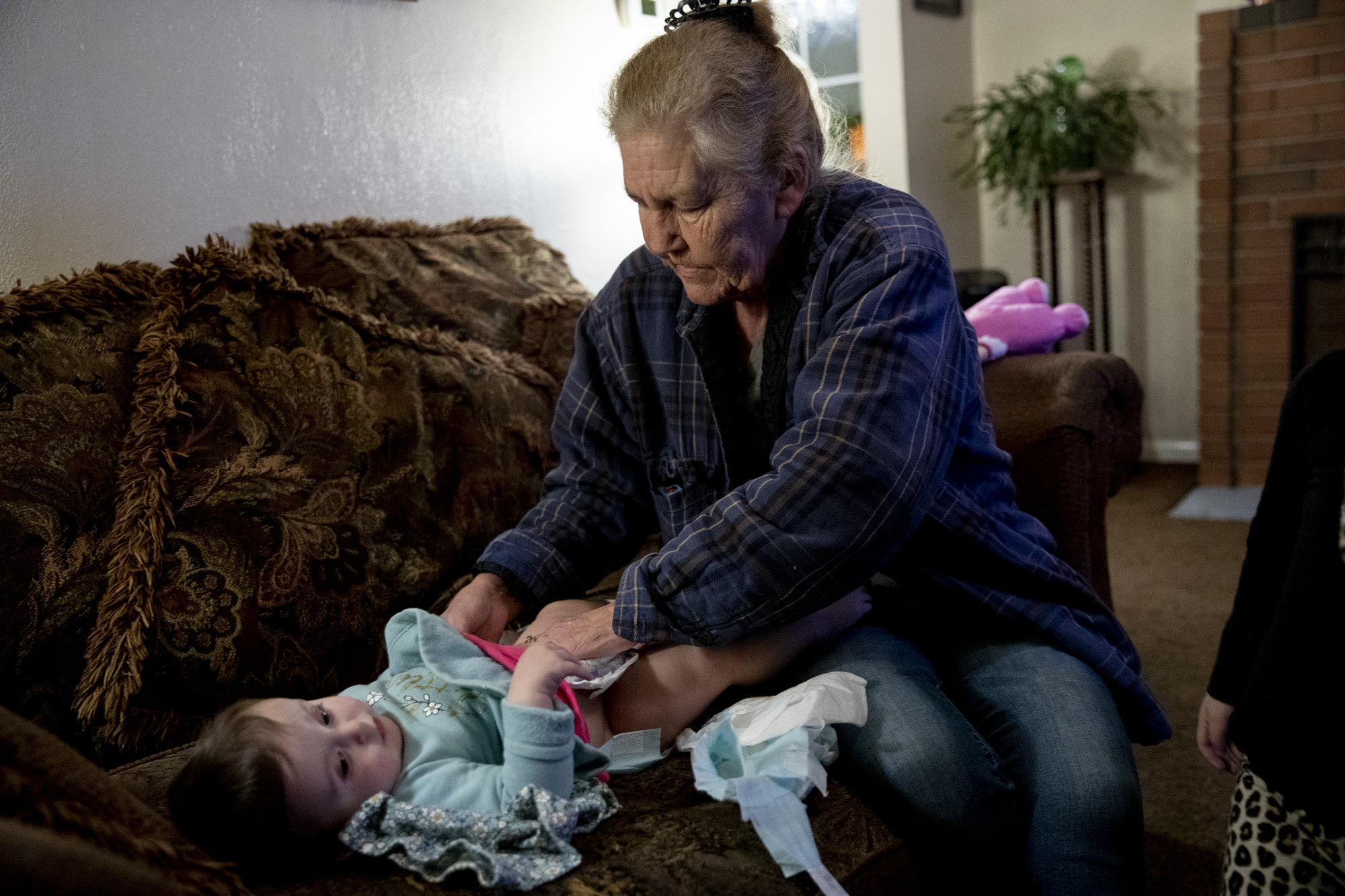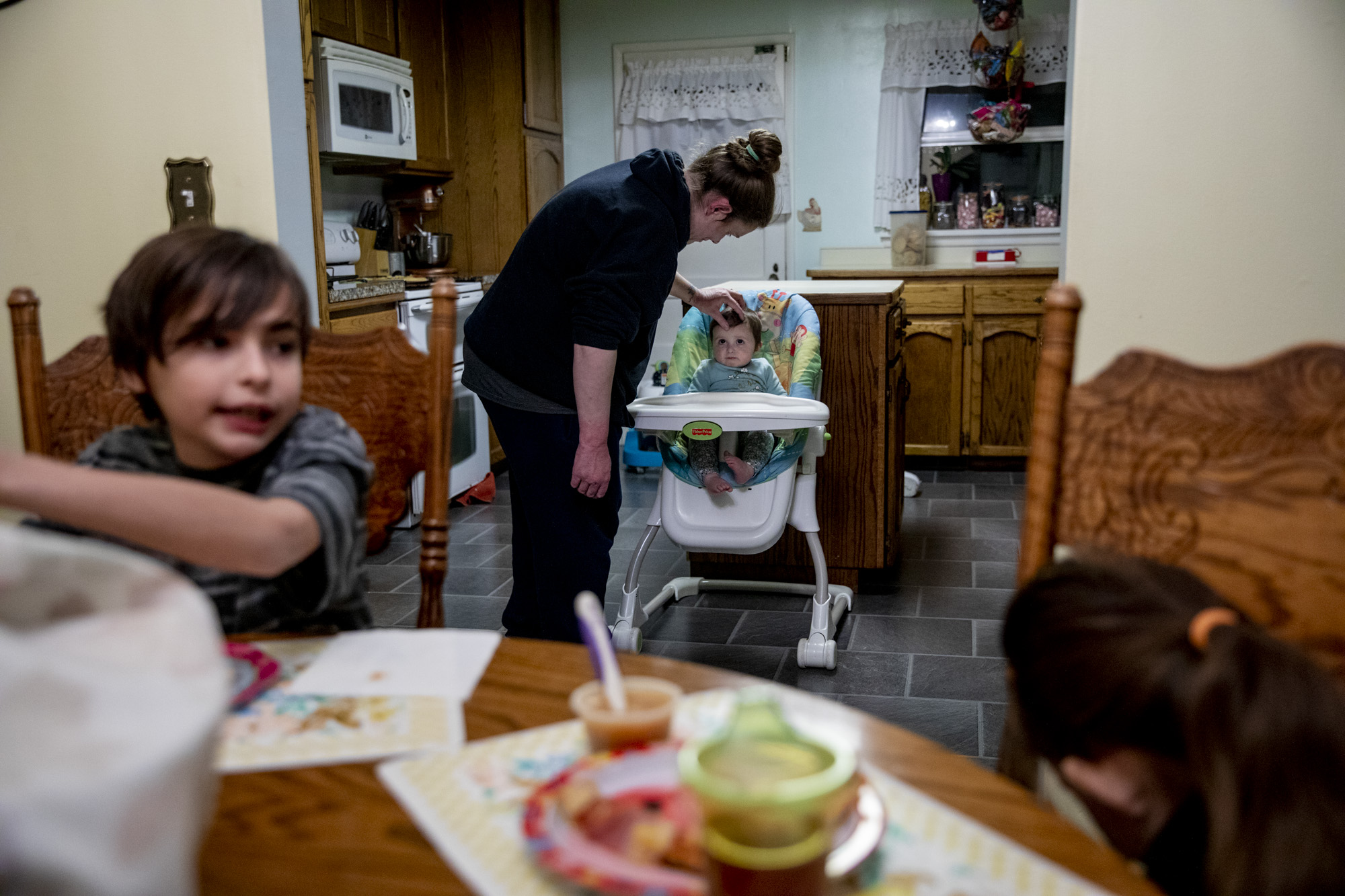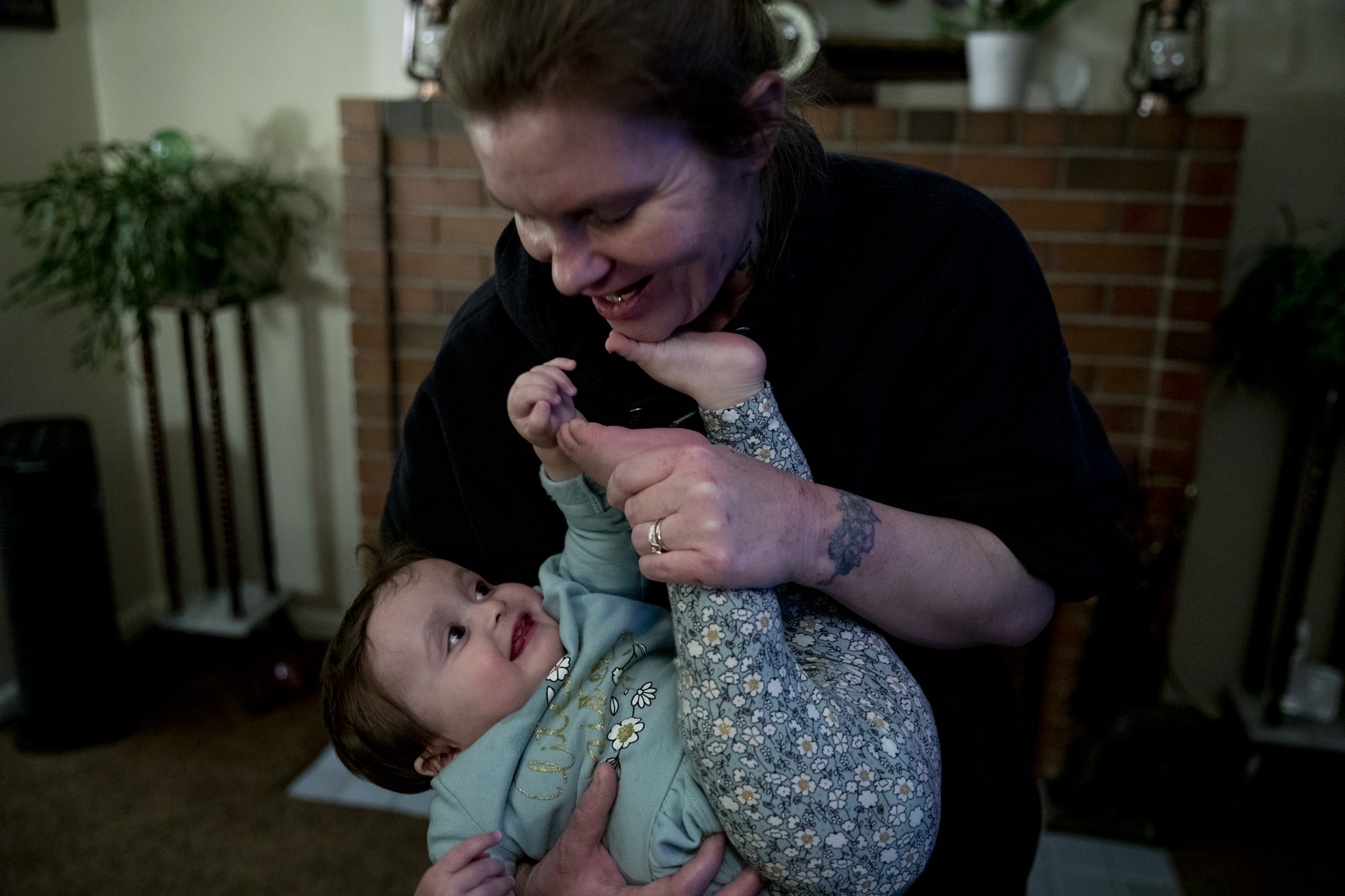Contained within the assorted letters was the story of Shamek's rocky relationship with the Temporary Assistance for Needy Families program (TANF), known to most simply as welfare. For Shamek, 38, the modest checks provided by the government had been a support to lean on after she gave birth to her first child as a teenager, when the father of her younger children was deported to Mexico, when she underwent surgery.
Shamek is no longer eligible for cash welfare. Her lifetime clock, which had been ticking off and on since 1999, has run out. A person can receive TANF benefits only for five years, and while she could have once requested and received an extension on the assistance, that is no longer the case. Since 2011, Washington state has made it far more difficult for families like hers to be approved for extra time.
Family poverty in Washington state remains stubbornly high, yet the hard cap, paired with other restrictive post-recession policies, means the state's budget for cash assistance is a fraction of what it once was. As many other states have gradually restored TANF spending to pre-housing crash levels, Washington has not. And so, at a time of both great prosperity and staggering levels of homelessness in Washington, thousands fewer poor families in the state access the benefit compared with a decade ago.
Shamek has no income. She's still recovering from surgery on a triple hernia, a fresh scar running vertically up her stomach. She and her three youngest children (she has four total) live with her parents in their Skyway home. On forms, she lists their mailing address as her own, but writes "homeless" on the line asking for her place of residence.
She'd like to work, but that would mean leaving her children — two of whom are not yet school age — with her parents all day, a burden they're unprepared to accept on their fixed incomes. She’s embarrassed by the clothes she owns and the state of her teeth, which were damaged in a car crash. With a resume anchored only by her time working at a roller-skating rink, she’s unsure of even where to begin. She feels lost, forgotten and judged.

“They're supposed to be safety nets for people,” she said of the Department of Social and Health Services, which administers TANF. “And if they're not there, what are they advertising it for, really? Because what I need, I can't get it at all.”
"It's embarrassing," she said. "I'm not working and I have kids. I should be able to provide for my kids."
Declining cash assistance
Cash welfare was once a spinoff of Social Security, allotted directly from the federal government to low-income families. But when President Bill Clinton signed TANF into law in 1996, the nation’s welfare program was transformed into a program administered by the states and reliant on grants from the federal government.
The shift was intended to make welfare a program of “personal responsibility,” in which states would pressure participants away from the benefit and into the workforce. In addition to using the funds to provide financial support, states were allowed to spend TANF allotments on child care, trade schools, family planning and a wide range of other programs.
To receive these grants and avoid penalties from the feds, states were required to match federal dollars with additional spending from their own budgets. For nearly 15 years, Washington met its obligation by dedicating hundreds of millions of dollars toward what many view as the core function of TANF: cash assistance for poor families.
But the onset of the Great Recession a decade ago accelerated Washington’s move away from cash assistance to satisfy those requirements.
Rather than allocating money directly to families, the state meets its obligations to the federal government by claiming that programs it was likely to fund anyway — such as workers compensation and public education — count toward TANF. The state, meanwhile, has implemented restrictive policies that make it harder for families to remain on the program.
Advocates for cash benefits call it a wag-the-dog trick that has allowed Washington to quietly pull back from providing income for poor families without risking penalties from the feds.
The results are stark.
According to state and federal records, Washington spent just over $13 million of its own money on basic cash assistance in 2018. Compare that with 1998, when Washington state spent over $228 million — or about $360 million in today's dollars. In just the past 10 years, yearly state contributions to cash welfare have plummeted by $150 million, from $163 million.
If the amount includes the federal grant, poor Washington families last year received about $135 million in cash help. Adjusted for inflation, that number was $436 million in 2010 and over $700 million in 1998.
The drop in spending does not reflect a drop in need. Last year, just 29 of 100 Washington families with incomes below the poverty line received welfare income — down from 62 out of 100 in 2006. In the decade between 2006 and 2016, Washington saw a steeper decline in the proportion of poor families receiving cash assistance than any other state.
The impacts fall especially hard on people of color, in particular Black families, who are removed from the program in disproportionate numbers.
On paper, Washington still claims over $1 billion a year in TANF spending, a sizable number that keeps the state in good standing with the federal government. But the federal government's list of expenditures that qualify as TANF spending is broad and may surprise those who associate welfare with cash assistance.
In particular: Last year, Washington counted $239 million worth of TANF spending — nearly double what it spent on cash assistance — toward "preventing out-of-wedlock pregnancies."
This category, promoted by conservative Christian lawmakers as the law was drafted in the ‘90s, is one of four allowed by the federal government under the TANF program.
In 2007, Washington spent nothing on “preventing out of wedlock pregnancies”; by 2018, it spent more on that category than any other state. For instance, the state uses the category to count over $200 million budgeted for public education — specifically, a learning assistance program housed in the state Office of the Superintendent of Public Instruction and not related to sex education — as helping the state meet its TANF goals, according to state spending data.
Pregnancy prevention now accounts for 39% of the state’s TANF contributions, while just 2% went to cash assistance — down from its peak of 70% in 1998.
Outside of pregnancy prevention, Washington in 2018 also labeled $125 million of TANF spending as simply “other.” Most of that — $111 million — went to the Department of Labor and Industries, where it funded workers compensation, according to data provided by DSHS.
Advocates for restoring cash assistance to previous levels allow that the programs being funded through the "preventing out-of-wedlock pregnancies" or “other” categories may be worthy, but argue TANF spending should prioritize its core purpose of providing cash relief and not cover basic duties of the state.
"A lot of things get claimed under the preventing pregnancy purpose and other purposes that are not necessarily improper or illegal," said Liz Schott, a senior fellow with the Center on Budget and Policy Priorities' Family Income Support Division, "but the question is, is this really what the TANF money should go toward when it's servicing so few families that are deeply poor?"
A ‘painful’ time in Washington
Former state Rep. Ruth Kagi looks back on the years after the financial crisis of 2008 as one of the most "truly painful" times in her career.
"It was devastating. I can't even begin to portray how devastating it was," she said recently. "We had to cut $8 billion out of the budget, which at the time was unbelievable. We didn't have very many choices."
In the fever to get the state's budget in order, nothing was spared, including welfare.
Over the course of several years, the state did a number of things to reduce the program’s budget. Most dramatically, it greatly limited extensions on the lifetime five-year time limit, a move that cut 4,500 families from the program in a matter of months. Legislators also shortened the period a family could be out of compliance with program requirements before they lost their benefits, raised orientation requirements and made it so families could be permanently disqualified from receiving benefits.
Where caseloads once rose and fell with the number of families in poverty, the two began to diverge. Last year, roughly 20,000 families that would likely have qualified for cash assistance before 2011 did not receive anything.
"The legislators weren't making those decisions because they thought they were the best policies that would support families in Washington State," said Liz Olson with the Washington State Budget & Policy Center. "They made those decisions because there was a budget crisis, and they needed to cut spending."
"Certainly the rules around TANF at a state level have gotten more restrictive," said Babs Roberts, director of the DSHS Community Services Division. "The ancillary effect is there is likely a perception that the program is not as available. I think the numbers support that perception."
As a result of the legislators' decision to make TANF more restrictive, restoring cash assistance to its previous levels is more complicated than simply increasing the budget.
"I wish in retrospect we'd maybe have just cut the budget and not changed the policy," said Kagi.
The goal of TANF is to move families into self-sufficiency — it was created by the federal Personal Responsibility and Work Opportunity Reconciliation Act — but, said Olson, the budget reductions have not achieved that.
"As families are being pushed off of the TANF caseload, they are not moving into greater economic security," she said. "It often means folks are left with no income at all and that has really severe consequences for families."
The support from TANF through the years represented “a big sigh of relief" for Shamek as she struggled with health issues, a husband's deportation and raising her young children.
But as she and her family dipped on and off the program over nearly 20 years, she was unaware her lifetime limit was drawing closer. In 2017, she lost access to the benefit for good. Medically fragile, with two young children in tow and no income, Shamek moved in with her parents.
In 2018, a third of the families who lost their benefits were homeless at the time, according to the Center on Budget and Policy Priorities. Not all have the benefit of accommodating parents, like Shamek.
"What do they expect someone to do?" she said. "My parents are my safety net, but if I was outside, I'd be fucked."

At the same time, the effects of the recession-era changes tend to disproportionately impact people of color, especially Black families. While they make up 19% of TANF recipients, Black families were 30 percent of those removed in 2018, according to the Center on Budget and Policy Priorities.
Andrea Caupain is the CEO of Byrd Barr Place, which provides advocacy and services on behalf of poor Seattle residents.
"We saw Black families who still have not recovered [from the recession]," she said. "And so when we think about the TANF program, this disproportionately kicking people off of the program and unfairly sanctioning people, it's just another blow."
Rep. Debra Entenman, D-Kent, is one of a number of legislators pushing to increase accessibility to TANF. She introduced a bill in the Legislature this week in large part because of how hard the changes in the program have hit her Black constituents. "We have to ask ourselves honestly what are we doing? Why are we doing it and why is it disproportionately affecting a small part of our population?" she said.
Bryttni Seals — who was once in Entenman's district — has hit her lifetime limit. After a period on TANF, Seals, who's Black, completed medical office assistant training and last year landed a job with a Sea Mar community health clinic in South Seattle. At just over minimum wage, things remain tight, but she makes it work without TANF. She’s a self-described success story of the program.
But because the cap is for life, Seals, 30, with two young children, worries about the future. “If the company went down tomorrow, I’d be back to asking for benefits, applying for benefits, but I can’t get anymore benefits,” she said.
Last year, the Legislature rolled back some of the restrictive recession-era policies. Families can no longer be permanently removed from the program. Additionally, families experiencing homelessness are now eligible for an extension on their 60-month time limit.
The Legislature could go further this year. Entenman’s bill would allow families to stay longer on TANF, so long as they were in good standing with the program. It would also make the program more accommodating of families who temporarily fall out of compliance with TANF requirements. The changes would apply retroactively, meaning families who’ve been removed from the program could rejoin.
In the Senate, Joe Nguyen, D-West Seattle, has also pushed for restoring TANF to what it used to be, and even expanding it. His parents received welfare when he was growing up, and he credits the stability it provided with launching his successful life, first in tech and now in politics.
"The amount of money we estimate we needed on TANF was about $20,000," he said. "[Now] I pay more on taxes on that by myself in a year."
State estimates put the cost of returning TANF benefits to pre-2011 levels at about $18 million in 2020 and then over $27 million for each of at least the following three years. At those levels, roughly 1,700 additional families would receive cash assistance each year.
"Fundamentally, I'm OK with giving people money, getting them back on track and calling it good," he said.
Welfare's larger questions
Conversations about welfare benefits tend to open up larger, philosophical debates around poverty, work and the purpose of the social safety net. Since its overhaul in the mid-’90s, TANF has been fundamentally geared toward getting people off of the program. It is a lifeline to which a number of long and sometimes tangled strings have been attached. To remain in good standing with the program, families must commit themselves to a nearly full-time pursuit of finding work — often participating in over 30 hours a week of training or classes as part of their "individual responsibility plans."

Life is complicated for Shamek and her family. Her medical problems have worsened; she went through another round of surgery after the birth of her youngest child last year. She knows she needs to find work for stability, but without stability she struggles to find work.
The small TANF checks she once received meant she could buy her children diapers, pay her phone bill and help her parents with their utilities. But TANF is not intended to cover basic needs in perpetuity. Perhaps an extension on TANF would lead to a job and, eventually, a home for Shamek and her children. But perhaps not. For a mother years out of the workforce, the burden of complying with the full-time requirements of TANF while caring for three young children and relying on public transportation is a weighty one.
"They put all this pressure on you," she said. "They have you get down to their office and sit around for hours. It's hard. It's frustrating."
"Nothing that people living in poverty do to get out of poverty is peaceful or soothing," said Roberts of DSHS. A veteran of the department, she correctly guesses, without knowing anything about Shamek, many of the details of Shamek's life — that she has multiple children, that she's housing insecure, that she doesn’t have a car, that even getting to a job interview or orientation is itself an ordeal. She’s seen this all before, many times.
"I don't know the right answer,” she said. “I know that as a human being it feels to me as a value perspective that everyone deserves to have their needs met. What I'd like to see is a system that allows everyone to have access to services, meet their needs, a clean place to live and enough to eat so they can regain their ability to reenter society. For that you need to give people enough space or time to do that. It's really difficult to make assumptions that people know how to do that."



